| NAKAMURA JÛZÔ |
| SIX GENERATIONS | |||||
| Nakamura Jûzô I | |||||
|
The actor Nakamura Kichiemon I held the name of Nakamura Jûzô I from his youth to the 10th lunar month of 1759. |
|||||
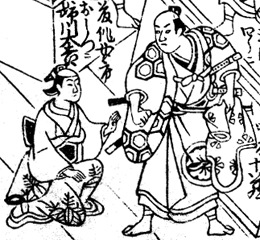 |
|||||
|
Anegawa Daikichi I (left) and Nakamura Jûzô I (right) playing the roles of Tôsaku's nyôbô Oshizu (in reality Shizuka Gozen) and Miura Shirô in the kaomise drama "Taihei Yamato Monogatari", which was staged in the 11th lunar month of 1756 in Ôsaka at the Kado no Shibai |
|||||
| Nakamura Jûzô II | |||||
|
The actor Nakamura Jûzô II held this name from the 11th lunar month of 1759 to the 6th lunar month of 1788. |
|||||
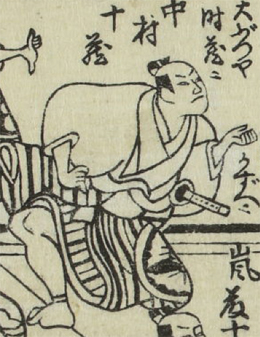 |
|||||
|
Nakamura Jûzô II playing the role of Daibutsuya Tokizô in the kaomise drama "Shinchoku Fukki no Kanatoko", which was staged in the 11th lunar month of 1767 in Kyôto |
|||||
| Nakamura Jûzô III | |||||
|
The actor Arashi Hinasuke II held the name of Nakamura Jûzô III from Spring 1789 to the 12th lunar month of 1793. |
|||||
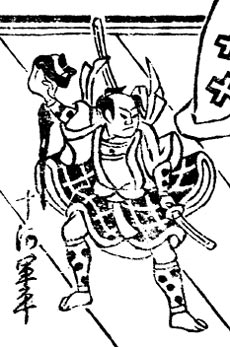 |
|||||
|
Nakamura Jûzô III playing the role of Gunpei in the drama "Gion Sairei Shinkôki", which was staged in the 11th lunar month of 1792 at the Kado no Shibai |
|||||
| Nakamura Jûzô IV Nakamura Jûzô IV |
|||||
| Dates of birth and death unknown. He was recorded in the zamoto section of the Edo hyôbanki from 1795 to 1798 (without any stage record). No record afterwards. | |||||
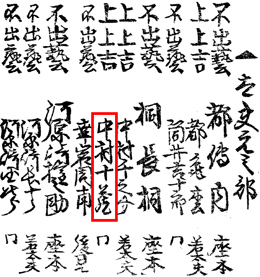 |
|||||
|
The name of Nakamura Jûzô IV in the 1795 Edo hyôbanki (the zone within the red box) |
|||||
| Nakamura Jûzô V Nakamura Jûzô V [1] |
|||||
|
Born in 1780. He started his career in Ôsaka miyaji shibai, performing in kodomo shibai under the name of Sakata Ichitarô. He became disciple of the actor Arashi Kichitarô III, became wakaonnagata and received the name of Arashi Ichitarô in the 11th lunar month of 1799 [3] to perform in Ôsaka at the Kita no Shinchi Shibai. He became a disciple of Kataoka Nizaemon VII, who gave him the name of Kataoka Matsusuke II [2] in the 3rd lunar month of 1806 [4] in Ise at the Naka-no-Jizô Shibai. He went to Edo in Fall 1813. He performed at the Moritaza in the kaomise drama "Gohiiki Tsunagi Uma". He achieved a great success by playing in the same theater in the 6th lunar month of 1814 the roles of the yakko Edohei, Takemura Sadanoshin and the menoto Shigenoi in the drama "Koi Nyôbô Somewake Tazuna". He took the name of Kataoka Gachô in the 11th lunar month of 1815 at the Nakamuraza, performing in the kaomise drama "Shitennô Oedo no Kaburaya", which also celebrated the shûmei of Onoe Kikugorô III and welcomed in Edo the actor Sawamura Tanosuke II. He became disciple of Bandô Mitsugorô III and took the name of Bandô Matajûrô III in the 11th lunar month of 1816 at the Kawarasakiza, where he performed in the kaomise drama "Kiyomori Eiga no Utena", which also celebrated the shûmei of Sôryô Jinroku II, Ôtani Bajû II, Sakata Hanjûrô, Ichikawa Momotarô I, Tsuuchi Monzaburô III and Ichikawa Kodanji III. He took the name of Nakamura Jûzô V [1] in the 11th lunar month of 1819 at the Nakamuraza, where he performed in the kaomise drama "Hana no Iro Yatsushi Kuronushi". He went back to Ôsaka in 1822 to perform mostly in hama shibai. He left Ôsaka in the first quarter of 1832 to perform in Nagoya. The weather was terrible, snow was heavily falling and he died frozen along with several of his travel companions while going through the Happô Pass [5] the 26th of the 1st lunar month of 1832 [6]. He was the father of Nakamura Matsusuke. There will be in the future to come a full page dedicated to Nakamura Jûzô V in kabuki21.com.
|
|||||
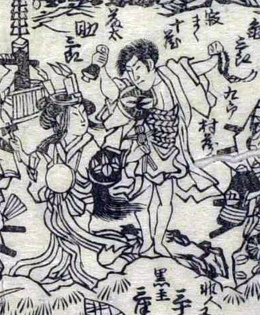 |
|||||
|
Nakayama Kamesaburô (bottom/left) and Nakamura Jûzô V (top/right) performing in the kaomise drama "Hana no Iro Yatsushi Kuronushi", which was staged in the 11th lunar month of 1819 at the Nakamuraza |
|||||
| Nakamura Jûzô VI | |||||
|
The actor Nakamura Juzô held the name of Nakamura Jûzô VI from October 1873 to December 1877. |
|||||
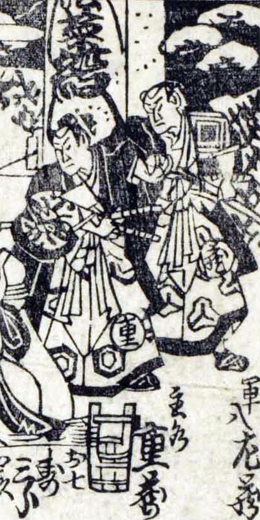 |
|||||
|
Nakamura Jûzô VI (bottom/left) performing in the drama "Shôchikubai Yuki no Akebono", which was staged in October 1873 at the Sawamuraza |
|||||
|
|
|||||
|
[1] Nakamura Jûzô IV in Nojima Jusaburô's book "Kabuki Jinmei Jiten" but Nakamura Jûzô V in the latest edition (2012) of "Kabuki Haiyû Meiseki Benran"; we've decided to stay in line with the later book. [2] Kataoka Matsusuke I in the latest edition (2012) of "Kabuki Haiyû Meiseki Benran"; we've decided to stay in line with Nojima Jusaburô's book "Kabuki Jinmei Jiten". [3] 1804 in Nojima Jusaburô's book "Kabuki Jinmei Jiten"; we've decided to stay in line with the latest edition (2012) of "Kabuki Haiyû Meiseki Benran". [4] The 7th lunar month of 1808 in Nojima Jusaburô's book "Kabuki Jinmei Jiten"; we've decided to stay in line with the latest edition (2012) of "Kabuki Haiyû Meiseki Benran". [5] Nowadays, it is called the Nenohira pass (Nenohira Tôge in Japanese). [6] The 21st day of the 2nd lunar month of the 3rd year of the Tenpô era was the 27th of February 1832 in the western calendar. |
|||||
|
|
| Contact | Main | Top | Updates | Actors | Plays | Playwrights | Programs | Links | FAQ | Glossary | Chronology | Illustrations | Prints | Characters | Derivatives | Theaters | Coming soon | News |